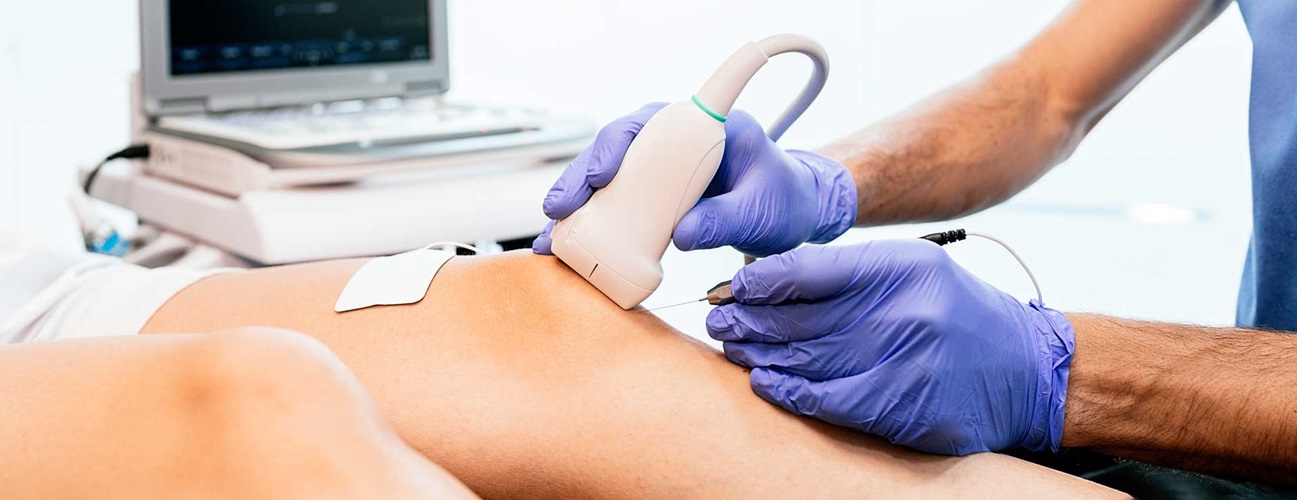Viscosupplementation Treatment for Arthritis
What is viscosupplementation treatment for arthritis?
During viscosupplementation treatment for arthritis, your healthcare provider injects hyaluronic acid into your joint. This thick fluid may help reduce pain and swelling in your arthritic joint (most commonly, your knee).
The bones that make up your joints usually have a cap of cartilage on their ends. This cartilage helps make sure that your bones move smoothly against each other. This cartilage has a fluid coating that contains hyaluronic acid. This works like a lubricant and shock absorber in your joint.
In osteoarthritis (“wear-and-tear” arthritis), this cartilage cap breaks down. When this happens, the bones of your joint scrape together abnormally. People with osteoarthritis generally have less hyaluronic acid in their joints than they should. All of this causes symptoms like pain, stiffness, and swelling. The idea behind viscosupplementation is that replacing this hyaluronic acid may help reduce symptoms.
Your healthcare provider may first inject a numbing medicine into the space around your knee joint and possibly drain any fluid that is causing the joint to swell. Then, your healthcare provider will inject hyaluronic acid into the space inside your joint. You shouldn’t expect this to reduce your pain right away. After the full course of treatment, though, you may notice some pain relief.
Why might I need viscosupplementation treatment for arthritis?
You may have already tried other treatments for your arthritis, like over-the-counter pain medicines and corticosteroid injections. If you still have significant symptoms, viscosupplementation might be a good choice to help reduce your pain, stiffness, and swelling. The treatment seems to work best in people with mild or moderate arthritis. The treatment may particularly make sense if you are trying to delay getting surgery on your joint.
Generally, healthcare providers use viscosupplementation to treat osteoarthritis, but the technique may also benefit people with certain other kinds of arthritis, like rheumatoid arthritis. You can talk to your healthcare provider about whether it is a choice for your type of arthritis.
Hyaluronic acid injection is not a treatment choice for arthritis in all types of joints. The knee is the standard injection site, but you might also be able to get it for arthritis in your hip or possibly in another location.
What are the risks for viscosupplementation treatment for arthritis?
Most people don’t have any problems from viscosupplementation, but a small percentage of people do have problems.
The most common problem you might encounter is a flare-up of your arthritis just after your injection. This might cause additional pain and swelling in the short term. Healthcare providers are still learning about the best techniques to help reduce the chances of this complication.
Less common risks include:
- Bleeding
- Allergic reaction
- Pain at the injection site
- Infection (you should delay your injection if you have any active infection to help prevent this)
There is also a chance that the treatment will not effectively help your symptoms. Talk to your healthcare provider about all your concerns. Your own risks may vary according to your medical conditions and where and how often you get injections.
How do I prepare for viscosupplementation treatment for arthritis?
Talk to your healthcare provider about all your medical conditions. Tell your healthcare provider about all the medicines you take, including over-the-counter medicines, like aspirin. Take all of your medicines as normal, unless your healthcare provider tells you otherwise.
The day of your procedure, you can eat and drink as you normally would. Tell your healthcare provider about any new symptoms, like fever. You may want to wear loose clothing so that you can easily expose your joint. Your healthcare provider might give you other instructions about what to do before your procedure.
What happens during viscosupplementation treatment for arthritis?
Viscosupplementation is a relatively quick procedure that you probably can have done during a normal office visit. In general:
- Your healthcare provider will clean the area where you’ll have your injection.
- Usually, your healthcare provider will inject a local anesthetic into the area around your joint, so you won’t feel any pain or discomfort in the area during the treatment. Your healthcare provider might use an anesthetic spray instead.
- In some cases, your healthcare provider might use imaging so that he or she can inject into exactly the right spot. Your healthcare provider might use ultrasound or another device that shows continuous X-rays.
- If you have excess fluid in your joint, your healthcare provider might remove a small amount of fluid before beginning.
- Your healthcare provider will inject the hyaluronic acid into the joint space using a needle attached to a syringe.
- A small bandage will be applied to your injection site.
Your healthcare provider can give you an even more specific idea of what to expect. Depending on the type of product you use, you may not need another shot, or you might need one to four more spread out over the next several weeks.
What happens after viscosupplementation treatment for arthritis?
You should be able to go home shortly after your procedure. Ask your healthcare provider if it is OK for you to drive. For about 48 hours, you should avoid standing for long periods, excessive walking, jogging, or lifting heavy weights.
Some people have slight pain, warmth, and swelling right after their procedure. These symptoms usually don’t last long. Using an ice pack may help. Tell your healthcare provider right away if these symptoms don’t go away soon, or if you have severe warmth, redness, pain, or high fever. Follow all your healthcare provider’s instructions about medicines and follow-up care.
Make sure to keep all of your future appointments. The procedure may not work effectively if you do not receive the full series of injections.
You should not expect your hyaluronic acid injection to relieve your symptoms immediately. It may take several weeks before you begin to notice a difference. Your relief from symptoms may last for several months.
If viscosupplementation is effective for you, you may be able to repeat the injection (or series of injections) in 6 months or so. The procedure doesn’t help everyone, though. If the procedure doesn’t work for you, continue to talk to your healthcare provider about other treatment choices, like joint surgery.
Next steps
Before you agree to the test or the procedure make sure you know:
- The name of the test or procedure
- The reason you are having the test or procedure
- What results to expect and what they mean
- The risks and benefits of the test or procedure
- What the possible side effects or complications are
- When and where you are to have the test or procedure
- Who will do the test or procedure and what that person’s qualifications are
- What would happen if you did not have the test or procedure
- Any alternative tests or procedures to think about
- When and how will you get the results
- Who to call after the test or procedure if you have questions or problems
- How much will you have to pay for the test or procedure






